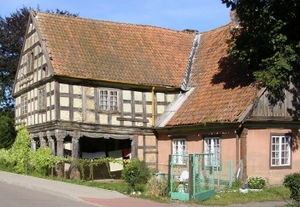Difference between revisions of "Biesterfelde (Pomeranian Voivodeship, Poland)"
| [checked revision] | [checked revision] |
GameoAdmin (talk | contribs) (CSV import - 20130823) |
m (Added categories and added image.) |
||
| Line 1: | Line 1: | ||
| − | [[File:Bystrze%20map.jpg|300px|thumb|right|''Biesterfelde (now known as Bystrze, Poland) | + | [[File:Kunzendorf-Biesterfelde.jpg|300px|thumbnail|left|''Detailed map of Biesterfelde.<br /> Source: Archiwum Map Zachodniej Polski<br /> http://amzpbig.com/maps/1979_Gnojau_1913.jpg''.]] |
| − | + | [[File:Bystrze%20map.jpg|300px|thumb|right|''Biesterfelde (now known as Bystrze, Poland)<br /> | |
| − | Source: [http://en.wikipedia.org/wiki/Bystrze,_Pomeranian_Voivodeship Wikipedia Commons]'']] | + | Source: [http://en.wikipedia.org/wiki/Bystrze,_Pomeranian_Voivodeship Wikipedia Commons]'']] |
| − | + | [[File:Bystrze.jpg|300px|thumb|right|''Biesterfelde home, built in the early 19th century<br /> | |
| − | Source: [http://holland.org.pl/art.php Catalogue of Monuments of Dutch Colonization | + | Source: [http://holland.org.pl/art.php Catalogue of Monuments of Dutch Colonization in Poland]'']] |
| − | + | Biesterfelde (also known as Bysterfeld, Bysterfelde, Biesterfeld, Beisterfeld, Biesterfelde; now known as Bystrze; coordinates: 54.036005, 18.854255 [54° 2′ 9″ N, 18° 51′ 15″ E]; population in 1852, 261; in 1905, 211; in 2012, 220), is located approximately 5 kilometres (3 miles) north-west of Miłoradz ([[Mielenz (Pomeranian Voivodeship, Poland)|Mielenz]]), 12 km. (7 mi.) west of Malbork ([[Marienburg (Pomeranian Voivodeship, Poland)|Marienburg]]), and 40 km. (25 mi.) south of the regional capital Gdańsk ([[Danzig (Poland)|Danzig]]). Biesterfelde was situated to the south of Kunzendorf and immediately north of the small settlement of Adlig Renkau. | |
| − | |||
The village was founded by Ludolf König, the Grand Master of the Teutonic Knights, on 36 włókas (646 hectares) under the name Bysterfeld. The church mentioned in the 16th century was demolished in the 19th century. The old estate Renkau (Rękowo) was incorporated into the village. Until 1772 the village was part of the Kingdom of [[Poland|Poland]]. The First Partition of Poland resulted in the creation of a new province in 1773, called [[West Prussia|West Prussia]]. Biesterfelde was situated in the district (Kreis) of Marienburg until the establishment of the [[Danzig, Free City of|Free City of Danzig]] in 1920. The village came under the control of Nazi Germany during World War II until February 1945, when it was occupied by Soviet forces and returned to Poland. In 2012 Biesterfelde (now Bystrze) was a village in the administrative district of Gmina Miłoradz, within Malbork County, Pomeranian Voivodeship. | The village was founded by Ludolf König, the Grand Master of the Teutonic Knights, on 36 włókas (646 hectares) under the name Bysterfeld. The church mentioned in the 16th century was demolished in the 19th century. The old estate Renkau (Rękowo) was incorporated into the village. Until 1772 the village was part of the Kingdom of [[Poland|Poland]]. The First Partition of Poland resulted in the creation of a new province in 1773, called [[West Prussia|West Prussia]]. Biesterfelde was situated in the district (Kreis) of Marienburg until the establishment of the [[Danzig, Free City of|Free City of Danzig]] in 1920. The village came under the control of Nazi Germany during World War II until February 1945, when it was occupied by Soviet forces and returned to Poland. In 2012 Biesterfelde (now Bystrze) was a village in the administrative district of Gmina Miłoradz, within Malbork County, Pomeranian Voivodeship. | ||
| Line 22: | Line 21: | ||
[[Map:Bystrze (Pomeranian Voivodeship, Poland)|Map:Bystrze (Pomeranian Voivodeship, Poland)]] | [[Map:Bystrze (Pomeranian Voivodeship, Poland)|Map:Bystrze (Pomeranian Voivodeship, Poland)]] | ||
{{GAMEO_footer|hp=|date=October 2012|a1_last=Thiessen|a1_first=Richard D|a2_last=|a2_first=}} | {{GAMEO_footer|hp=|date=October 2012|a1_last=Thiessen|a1_first=Richard D|a2_last=|a2_first=}} | ||
| + | [[Category:Cities, Towns, and Villages]] | ||
| + | [[Category:Cities, Towns, and Villages in Poland]] | ||
Revision as of 16:23, 9 August 2014

Source: Archiwum Map Zachodniej Polski
http://amzpbig.com/maps/1979_Gnojau_1913.jpg.

Source: Catalogue of Monuments of Dutch Colonization in Poland
Biesterfelde (also known as Bysterfeld, Bysterfelde, Biesterfeld, Beisterfeld, Biesterfelde; now known as Bystrze; coordinates: 54.036005, 18.854255 [54° 2′ 9″ N, 18° 51′ 15″ E]; population in 1852, 261; in 1905, 211; in 2012, 220), is located approximately 5 kilometres (3 miles) north-west of Miłoradz (Mielenz), 12 km. (7 mi.) west of Malbork (Marienburg), and 40 km. (25 mi.) south of the regional capital Gdańsk (Danzig). Biesterfelde was situated to the south of Kunzendorf and immediately north of the small settlement of Adlig Renkau.
The village was founded by Ludolf König, the Grand Master of the Teutonic Knights, on 36 włókas (646 hectares) under the name Bysterfeld. The church mentioned in the 16th century was demolished in the 19th century. The old estate Renkau (Rękowo) was incorporated into the village. Until 1772 the village was part of the Kingdom of Poland. The First Partition of Poland resulted in the creation of a new province in 1773, called West Prussia. Biesterfelde was situated in the district (Kreis) of Marienburg until the establishment of the Free City of Danzig in 1920. The village came under the control of Nazi Germany during World War II until February 1945, when it was occupied by Soviet forces and returned to Poland. In 2012 Biesterfelde (now Bystrze) was a village in the administrative district of Gmina Miłoradz, within Malbork County, Pomeranian Voivodeship.
In 1776 two Mennonite families of nine people in total lived in Biesterfelde (Bergen and Ens). In 1820, the village had 166 residents, including 10 Mennonites.
Mennonites in Biesterfelde were members of the Heubuden Mennonite Church.
Bibliography
Stowarzyszenie Konserwatorów Zabytków. "Bystrze." Catalogue of Monuments of Dutch Colonization in Poland. 2005. Web. 8 October 2012. http://holland.org.pl/art.php?kat=obiekt&id=299&lang=en.
Wikipedia. ""Bystrze, Pomeranian Voivodeship." Web. 8 October 2012. http://en.wikipedia.org/wiki/Bystrze,_Pomeranian_Voivodeship.
Wolf, Hans-Jürgen. "Familienforschung in Westpreußen." Web. 8 October 2012. http://www.westpreussen.de.
Maps
Map:Bystrze (Pomeranian Voivodeship, Poland)
| Author(s) | Richard D Thiessen |
|---|---|
| Date Published | October 2012 |
Cite This Article
MLA style
Thiessen, Richard D. "Biesterfelde (Pomeranian Voivodeship, Poland)." Global Anabaptist Mennonite Encyclopedia Online. October 2012. Web. 22 Nov 2024. https://gameo.org/index.php?title=Biesterfelde_(Pomeranian_Voivodeship,_Poland)&oldid=123902.
APA style
Thiessen, Richard D. (October 2012). Biesterfelde (Pomeranian Voivodeship, Poland). Global Anabaptist Mennonite Encyclopedia Online. Retrieved 22 November 2024, from https://gameo.org/index.php?title=Biesterfelde_(Pomeranian_Voivodeship,_Poland)&oldid=123902.
©1996-2024 by the Global Anabaptist Mennonite Encyclopedia Online. All rights reserved.
